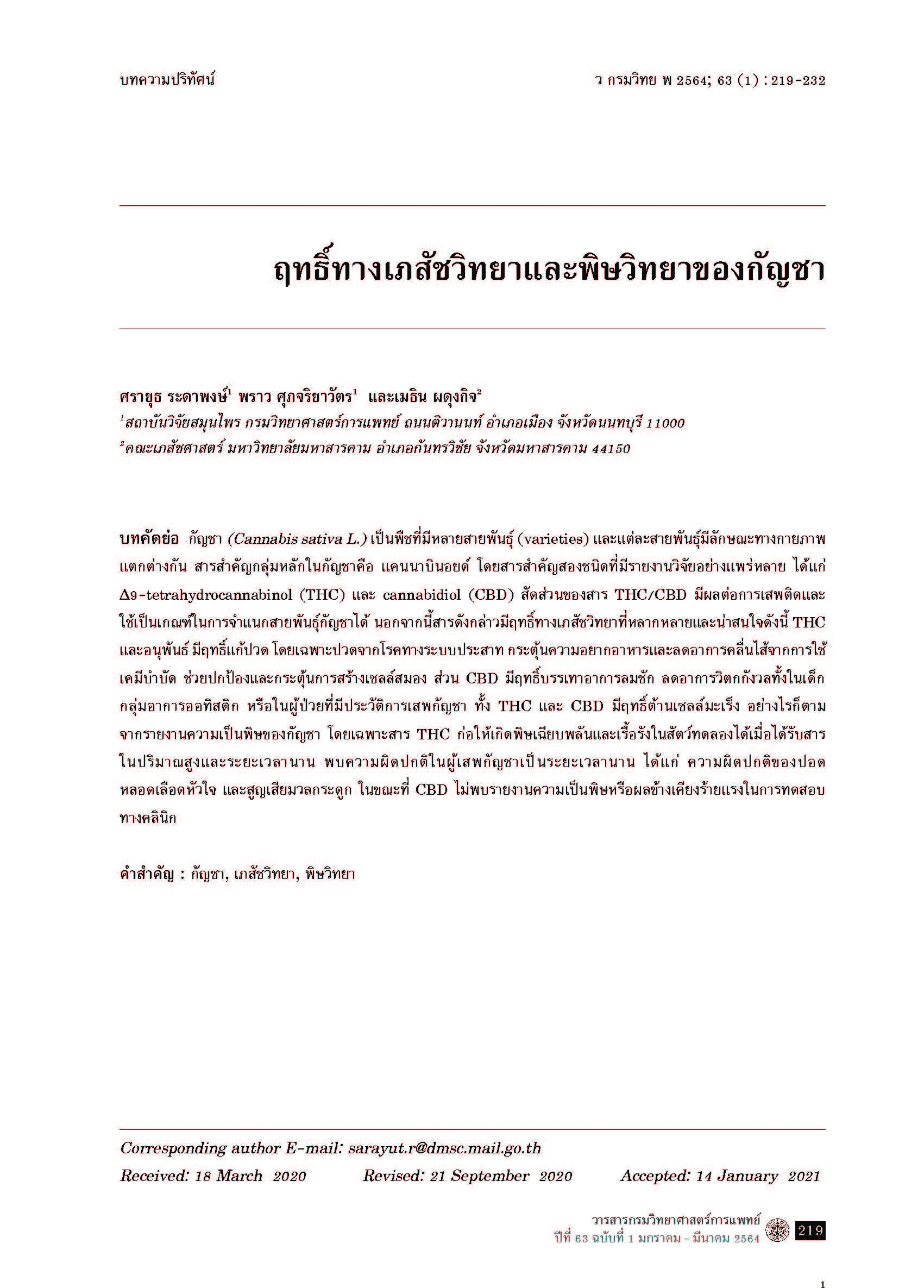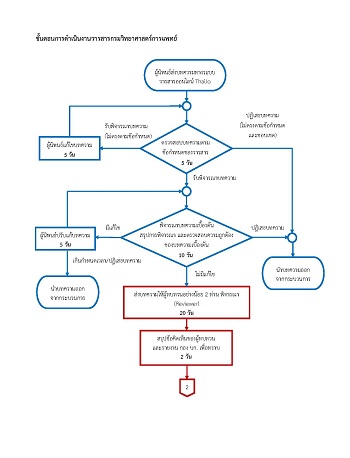ฤทธิ์ทางเภสัชวิทยาและพิษวิทยาของกัญชา
คำสำคัญ:
กัญชา, เภสัชวิทยา, พิษวิทยาบทคัดย่อ
กัญชา (Cannabis sativa L.) เป็นพืชที่มีหลายสายพันธุ์ (varieties) และแต่ละสายพันธุ์มีลักษณะทางกายภาพแตกต่างกัน สารสำคัญกลุ่มหลักในกัญชาคือ แคนนาบินอยด์ โดยสารสำคัญสองชนิดที่มีรายงานวิจัยอย่างแพร่หลาย ได้แก่ Δ9-tetrahydrocanna-binol (THC) และ cannabidiol (CBD) สัดส่วนของสาร THC/CBD มีผลต่อการเสพติดและใช้เป็นเกณฑ์ในการจำแนกสายพันธุ์กัญชาได้ นอกจากนี้สารดังกล่าวมีฤทธิ์ทางเภสัชวิทยาที่หลากหลายและน่าสนใจดังนี้ THC และอนุพันธ์ มีฤทธิ์แก้ปวด โดยเฉพาะปวดจากโรคทางระบบประสาท กระตุ้นความอยากอาหารและลดอาการคลื่นไส้จากการใช้เคมีบำบัด ช่วยปกป้องและกระตุ้นการสร้างเซลล์สมอง ส่วน CBD มีฤทธิ์บรรเทาอาการลมชัก ลดอาการวิตกกังวลทั้งในเด็กกลุ่มอาการออทิสติก หรือในผู้ป่วยที่มีประวัติการเสพกัญชา ทั้ง THC และ CBD มีฤทธิ์ต้านเซลล์มะเร็ง อย่างไรก็ตามจากรายงานความเป็นพิษของกัญชา โดยเฉพาะสาร THC ก่อให้เกิดพิษเฉียบพลันและเรื้อรังในสัตว์ทดลองได้เมื่อได้รับสารในปริมาณสูงและระยะเวลานาน พบความผิดปกติในผู้เสพกัญชาเป็นระยะเวลานาน ได้แก่ ความผิดปกติของปอดหลอดเลือดหัวใจและสูญเสียมวลกระดูก ในขณะที่ CBD ไม่พบรายงานความเป็นพิษหรือผลข้างเคียงร้ายแรงในการทดสอบทางคลินิก
เอกสารอ้างอิง
Small E, Cronquist A. A practical and natural taxonomy for Cannabis. Taxon 1976; 25(4): 405-35.
Hillig KW. Genetic evidence for speciation in Cannabis (Cannabaceae). Genet Resour Crop Evol 2005; 52(2): 161-80.
Watts G. Cannabis confusions. BMJ 2006; 332(7534): 175-6.
Piomelli D, Russo EB. The Cannabis sativa versus Cannabis indica debate: an interview with Ethan Russo, MD. Cannabis Cannabinoid Res 2016; 1(1): 44-6.
Woodbridge M, ผู้แต่ง. วารุณี เศวตประวิชกุล, สุชาดา นิลกำแหง วิลคินส์, ธรรศ ธารีสุชีวกุล, ผู้แปล ข้อมูลเบื้องต้นเกี่ยวกับกัญชาทางการแพทย์: หนังสือแนะนำการใช้กัญชาเพื่อบำบัดโรค. กรุงเทพฯ: องค์การเภสัชกรรม; 2562.
ประภัสสร ทิพรัตน์. พืชกัญชา: ความรู้ทั่วไปและการตรวจสอบสารสำคัญ. [ออนไลน์]. 2563; [สืบค้น 10 ก.พ. 2563]; [17 หน้า]. เข้าถึงได้ที่: URL: https://www.oncb.go.th/ncsmi/cannabis4/พืชกัญชา%20%20ความรู้ทั่วไปและการตรวจสอบสารสำคัญ.pdf.
Pollio A. The name of Cannabis: a short guide for Nonbotanists. Cannabis Cannabinoid Res 2016; 1(1): 234-8.
ราชบัณฑิตยสถาน. หนังสืออนุกรมวิธานพืช อักษร ก. พิมพ์ครั้งที่ 2. กรุงเทพฯ: หจก. อรุณการพิมพ์; 2547.
Anderson LC. Leaf variation among Cannabis species from a controlled garden. Bot Mus Lealf Harv Univ 1980; 28(1): 61-9.
McPartland JM. Cannabis systematics at the levels of family, genus, and species. Cannabis Cannabinoid Res 2018; 3(1): 203-12.
Hanus LO, Meyer SM, Munoz E, Taglialatela-Scafati O, Appendino G. Phytocannabinoids: a unified critical inventory. Nat Prod Rep 2016; 33(12): 1357-92.
Hill AJ, Williams CM, Whalley BJ, Stephens GJ. Phytocannabinoids as novel therapeutic agents in CNS disorders. Pharmacol Ther 2012; 133(1): 79-97.
Moreau M, Ibeh U, Decosmo K, Bih N, Yasmin-Karim S, Toyang N, et al. Flavonoid derivative of Cannabis demonstrates therapeutic potential in preclinical models of metastatic pancreatic cancer. Front Oncol 2019; 9: 660. (9 pages).
Bonini SA, Premoli M, Tambaro S, Kumar A, Maccarinelli G, Memo M, et al. Cannabis sativa: a comprehensive ethnopharmacological review of a medicinal plant with a long history. J Ethnopharmacol 2018; 227: 300-15.
Sirikantaramas S, Taura F. Cannabinoids: biosynthesis and biotechnological applications. In: Chandra S, Lata H, ElSohly MA, editors. Cannabis sativa L - botany and biotechnology. Champaign, Illinois: Springer International Publishing; 2017. p. 183-206.
กรมการแพทย์ กระทรวงสาธารณสุข. คำแนะนำการใช้กัญชาทางการแพทย์. ฉบับปรับปรุงครั้งที่ 1/2562. [ออนไลน์]. 2562; [สืบค้น 10 ก.พ. 2563]; [18 หน้า]. เข้าถึงได้ที่: URL: https://www.chiangmaihealth.go.th/cmpho_web/document/190609156008311353.PDF.
Lu H-C, Mackie K. An introduction to the endogenous cannabinoid system. Biol Psychiatry 2016; 79(7): 516-25.
Whiting PF, Wolff RF, Deshpande S, Di Nisio M, Duffy S, Hernandez AV, et al. Cannabinoids for medical use: a systematic review and meta-analysis. JAMA 2015; 313(24): 2456-73.
Aran A, Cassuto H, Lubotzky A, Wattad N, Hazan E. Brief report: cannabidiol-rich cannabis in children with autism spectrum disorder and severe behavioral problems-a retrospective feasibility study. J Autism Dev Disord 2019; 49(3): 1284-8.
Scherma M, Satta V, Collu R, Boi MF, Usai P, Fratta W, et al. Cannabinoid CB1/CB2 receptor agonists attenuate hyperactivity and body weight loss in a rat model of activity-based anorexia. Br J Pharmacol 2017; 174(16): 2682-95.
Szaflarski JP, Bebin EM, Cutter G, DeWolfe J, Dure LS, Gaston TE, et al. Cannabidiol improves frequency and severity of seizures and reduces adverse events in an open-label add-on prospective study. Epilepsy Behav 2018; 87: 131-6.
Lim K, See YM, Lee J. A systematic review of the effectiveness of medical cannabis for psychiatric, movement and neurodegenerative disorders. Clin Psychopharmacol Neurosci 2017; 15(4): 301-12.
Daris B, Verboten MT, Knez Z, Ferk P. Cannabinoids in cancer treatment: therapeutic potential and legislation. Bosn J Basic Med Sci 2019; 19(1): 14-23.
Svendsen KB, Jensen TS, Bach FW. Does the cannabinoid dronabinol reduce central pain in multiple sclerosis? Randomised double blind placebo controlled crossover trial. BMJ. 2004; 329(7460): 253. (8 pages).
Nurmikko TJ, Serpell MG, Hoggart B, Toomey PJ, Morlion BJ, Haines D. Sativex successfully treats neuropathic pain characterised by allodynia: a randomised, double-blind, placebo-controlled clinical trial. Pain 2007; 133(1-3): 210-20.
Rice J, Cameron M. Cannabinoids for treatment of MS symptoms: state of the evidence. Curr Neurol Neurosci Rep 2018; 18(8): 50. (10 pages).
US FDA. FDA approves first drug comprised of an active ingredient derived from marijuana to treat rare, severe forms of epilepsy. [online]. 2018; [cited 2020 Feb 10]; [3 screens]. Available from: URL: https://www.fda.gov/news-events/press-announcements/fda-approves-firstdrug-comprised-active-ingredient-derived-marijuana-treat-rare-severe-forms.
Suliman NA, Taib CNM, Moklas MAM, Basir R. Delta-9-Tetrahydrocannabinol (Δ9-THC) induce neurogenesis and improve cognitive performances of male sprague dawley rats. Neurotoxic Res 2018; 33(2): 402-11.
Bilkei-Gorzo A, Albayram O, Draffehn A, Michel K, Piyanova A, Oppenheimer H, et al. A chronic low dose of Δ9-tetrahydrocannabinol (THC) restores cognitive function in old mice. Nat Med 2017; 23(6): 782-7.
Aso E, Juves S, Maldonado R, Ferrer I. CB2 cannabinoid receptor agonist ameliorates Alzheimer-like phenotype in AβPP/PS1 mice. J Alzheimers Dis 2012; 35(4): 847-58.
Chakravarti B, Ravi J, Ganju RK. Cannabinoids as therapeutic agents in cancer: current status and future implications. Oncotarget 2014; 5(15): 5852-72.
Velasco G, Sanchez C, Guzman M. Endocannabinoids and cancer. Handb Exp Pharmacol 2015; 231: 449-72.
ประกาศกระทรวงสาธารณสุข เรื่อง ระบุชื่อยาเสพติดให้โทษในประเภท 5 (พ.ศ. 2563). ราชกิจจานุเบกษา เล่ม 137 ตอนพิเศษ 290 ง (วันที่ 14 ธันวาคม 2563). หน้า 33-34.
Thompson GR, Rosenkrantz H, Schaeppi UH, Braude MC. Comparison of acute oral toxicity of cannabinoids in rats, dogs and monkeys. Toxicol Appl Pharmacol 1973; 25(3): 363-72.
Phillips RN, Turk RF, Forney RB. Acute toxicity of Δ9-tetrahydrocannabinol in rats and mice. Proc Soc Exp Biol Med 1971; 136(1): 260-3.
Bergamaschi MM, Queiroz RH, Zuardi AW, Crippa JA. Safety and side effects of cannabidiol, a Cannabis sativa constituent. Curr Drug Saf 2011; 6(4): 237-49.
Noble MJ, Hedberg K, Hendrickson RG. Acute cannabis toxicity. Clin Toxicol (Phila) 2019; 57(8): 735-42.
Thompson GR, Mason MM, Rosenkrantz H, Braude MC. Chronic oral toxicity of cannabinoids in rats. Toxicol Appl Pharmacol 1973; 25(3): 373-90.
Reece AS. Severe multisystem dysfunction in a case of high level exposure to smoked cannabis. BMJ Case Rep 2009; 2009. (7 pages).
Mukamal KJ, Maclure M, Muller JE, Mittleman MA. An exploratory prospective study of marijuana use and mortality following acute myocardial infarction. Am Heart J 2008; 155(3): 465-70.
Korantzopoulos P, Liu T, Papaioannides D, Li G, Goudevenos JA. Atrial fibrillation and marijuana smoking. Int J Clin Pract 2008; 62(2): 308-13.
Chan PC, Sills RC, Braun AG, Haseman JK, Bucher JR. Toxicity and carcinogenicity of Δ9-tetrahydrocannabinol in Fischer rats and B6C3F1 mice. Fundam Appl Toxicol 1996; 30(1): 109-17.
Marselos M, Karamanakos P. Mutagenicity, developmental toxicity and carcinogenicity of cannabis. Addict Biol 1999; 4(1): 5-12.
Aldington S, Harwood M, Cox B, Weatherall M, Beckert L, Hansell A, et al. Cannabis use and risk of lung cancer: a case-control study. Eur Respir J 2008; 31(2): 280-6.
Hashibe M, Ford DE, Zhang Z-F. Marijuana smoking and head and neck cancer. J Clin Pharmacol 2002; 42(S1): 103S-7S.
Sidney S, Quesenberry CP, Friedman GD, Tekawa IS. Marijuana use and cancer incidence (California, United States). Cancer Causes Control 1997; 8(5): 722-8.
Daling JR, Doody DR, Sun X, Trabert BL, Weiss NS, Chen C, et al. Association of marijuana use and the incidence of testicular germ cell tumors. Cancer 2009; 115(6): 1215-23.
Efird JT, Friedman GD, Sidney S, Klatsky A, Habel LA, Udaltsova NV, et al. The risk for malignant primary adult-onset glioma in a large, multiethnic, managed-care cohort: cigarette smoking and other lifestyle behaviors. J Neurooncol 2004; 68(1): 57-69.
Sharma P, Murthy P, Bharath MM. Chemistry, metabolism, and toxicology of cannabis: clinical implications. Iran J Psychiatry 2012; 7(4): 149-56.
วริศรา สุวรรณ. ความหลากหลายของสายพันธุ์กัญชา. [ออนไลน์]. 2562; [สืบค้น 5 พ.ย. 2563]; [4 หน้า]. เข้าถึงได้ที่: URL: https://erp.mju.ac.th/acticleDetail.aspx?qid=1065.
ส. สุทธิพันธ์. กัญชา สรรพยาแห่งความหวัง. [ออนไลน์]. 2563; [สืบค้น 5 พ.ย. 2563]; [23 หน้า]. เข้าถึงได้ที่ : URL: https://www.satapornbooks.co.th/imgadmins/product_pdf/201910_01_Kaancha.pdf.




